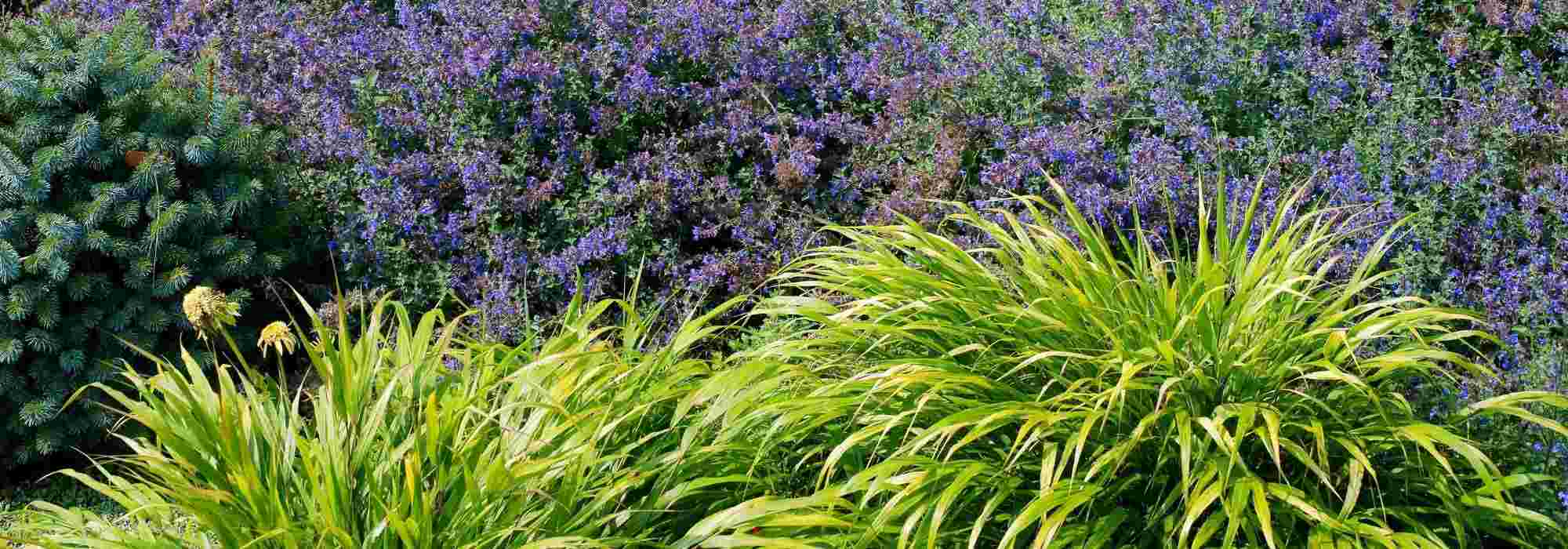
Hakonechloa: nice pairing ideas
Which plants to pair with Japanese grass for which atmospheres?
Contents
Hakonechloa, also known as Japanese grass, is a very easy plant to grow in the shaded areas of a garden, in cool, slightly acidic soil. Low maintenance and never sick, it grows slowly and eventually forms beautiful cushions with a languid habit. This graceful perennial, beautiful from spring to autumn, offers fine foliage with changing hues. Highly versatile in landscaping, it fits into various settings, from the most romantic to the most modern, and elegantly enhances balconies and terraces, as its pot culture poses no issues. How can you pair Hakonechloa? What other plants can you offer as companions? Discover our tips and ideas for beautiful combinations to create a garden that reflects your style.

In a Japanese-style garden
The creation of a Japanese garden must follow specific rules, but it is entirely possible to design a part of the garden in a zen spirit, starting with choosing plants emblematic of this style. Of course, Hakonechloa is essential. Its soft cushion-like habit works wonders at the foot of bushes that evoke the land of the rising sun. The golden hues of Hakonechloa ‘All Gold’ contrast beautifully with purple foliage, such as that offered by Japanese Maples like Acer ‘Garnet’, ‘Atropurpureum’, or ‘Red Pygmy’. To create a link, try Pieris japonica ‘Sarabande’, whose evergreen green foliage provides structure all year round. Its young purple leaves and spring flowering evolve the scene throughout the seasons. Reintroduce the golden hues of Hakonechloa by installing a heavenly bamboo ‘Lemon Lime’, which is also evergreen. For perennials, place the previous plants on a carpet of Helxine, with its mossy appearance, then let Japanese Primroses emerge, which colour the scene with their delicate corollas in spring, as well as Japanese Anemones, whose white, purple, or pink flowers enliven the end of the season, accompanying the changing hues of the maple and the Hakonechloa.
If space is not a concern, consider Camellias, Azaleas, and the very beautiful Chinese Viburnum (Viburnum plicatum), which appears covered in snow in spring and beautifully colours at the end of the season.

Hakonechloa macra ‘All Gold’, Acer palmatum ‘Dissectum Garnet’ (photo wallygrom), Helxine soleirolii (photo Wikipedia), Primula japonica ‘Miller’s Crimson’ and Nandina domestica ‘Lemon Lime’
In a woodland atmosphere
Shade is not synonymous with sadness in the garden, especially if it is not too dense. Hakonechloa macra ‘Aureola’, with its tender yellow and green variegated foliage, brings a lot of light to woodland or edge atmospheres. Pair it, for example, with Hostas, whose thick, crinkled foliage comes in various shades of green, blue, or yellow, sometimes with very graphic variegations. Their delicate flowering marks the arrival of summer, and some emit a subtle fragrance. It is unthinkable to evoke a woodland atmosphere without considering ferns. Their finely cut foliage pairs well with the linear leaves of Hakonechloa and contrasts with those of the Hostas. Among the Athyriums, the variety ‘Pictum’ stands out with its metallic grey foliage, enhanced by reddish hues. Among evergreen ferns, Dryopteris erythrosora adorns itself with young copper-orange fronds in spring, before returning to green for the rest of the year. In the background, install shrubs that enjoy the same conditions, such as Hydrangeas, with their generous inflorescences, Sarcococca, evergreen and whose late winter flowering is discreet but scents the air for metres around, or a Daphne with variegated foliage, also divinely fragrant at a time when many plants are still dormant. The white or pink flowers provide that extra light which may be lacking in the less exposed areas of the garden. The Tiarelle ‘Morning Star’ raises its pale pink spikes in spring, above beautiful cut foliage, green and brown. Next comes the glory moment of the Astrance ‘Star of Billion’, which displays its green-tinged white umbels for nearly 4 months, from June to September. Japanese Anemones, such as the classic ‘Honorine Jobert’, then take over in autumn. To complete the cycle, insert a few feet of Oriental Hellebores. These beautiful shade perennials offer a wide range of colours, and some bloom as early as the beginning of the year.
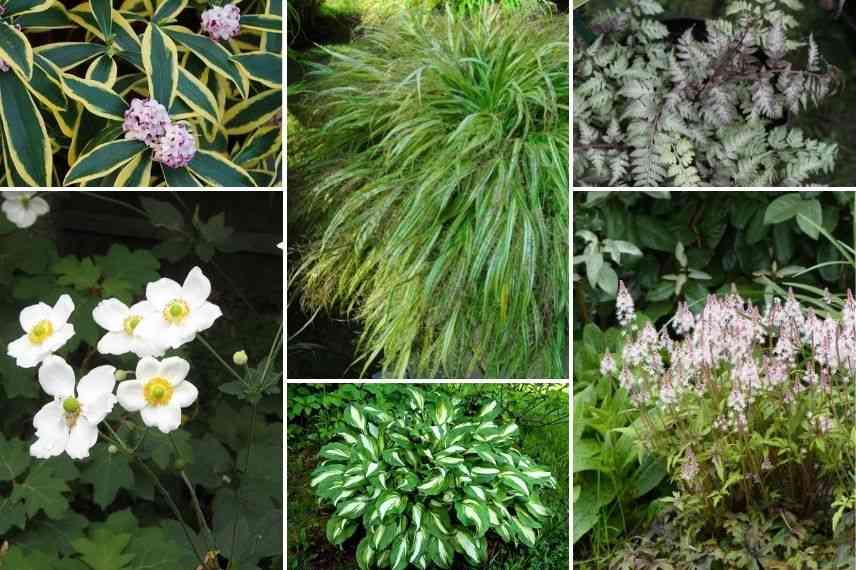
Daphne odora ‘Marianni Rogbret’ (photo P_Van_Rijssen), Hakonechloa macra ‘Aureola’, Athyrium niponicum ‘Pictum’, Japanese Anemone ‘Honorine Jobert’ (photo Wikipedia), Hosta and Tiarella ‘Morning Star’
Discover other Hakonechloa
View all →Available in 0 sizes
Available in 1 sizes
Available in 0 sizes
Available in 2 sizes
Available in 2 sizes
Available in 1 sizes
Available in 2 sizes
Available in 2 sizes
Available in 2 sizes
Available in 2 sizes
In a graphic and minimalist garden
The sleek design of Hakonechloa is perfect for contemporary landscaping. Choose a limited number of different plants and combine them in repetition. Hakonechloa ‘Albostriata’ may be the most suitable option, with its green and cream-white foliage. Plant it in clumps at the base of decorative-barked trees, such as Birches. Betula ‘Jacquemontii’ is immaculately white, while ‘Fascination’ offers a coppery trunk. Betula ‘Royal Frost’ is more compact, and its chocolate-purple foliage contrasts with both its light bark and the foliage of Hakonechloa. Some dogwoods, such as Cornus ‘Golden Shadow’ or Cornus alternifolia ‘Argentea’, due to their reasonable size (around 3m), are suitable for small gardens. For larger spaces, Cornus controversa ‘Variegata’ is an architectural marvel, with its branches held in horizontal tiers. In a different style, bamboos, especially when their canes are cleared on their lower third, impart a very modern feel to a landscape. Some, like Golden Bamboo (golden to orange canes) or Black Bamboo (black culms) need to be contained by a root barrier, but there are varieties that do not spread, such as Fargesias, which are generally smaller as well. In terms of perennials, Cimicifugas (or Actae) create beautiful verticals, while Ophiopogon ‘Nigrescens’ forms carpets of intensely black gramineous leaves.

Cornus alternifolia ‘Golden Shadows’, Phyllostachys aurea, Cimicifuga, Hakonechloa macra ‘Albostriata’ and Himalayan white Birch (photo w cutler)
In a colourful autumn display
In autumn, Hakonechloas take on honey, yellow, orange, or golden hues. Hakonechloa ‘Nicolas’ is renowned for its subtle combination of gold, bronze, and orange. Pair it with bushes that ignite with colour. The Aronia arbutifolia ‘Brillant’ is one such example, with its leaves turning a deep red at the end of the season, after producing lovely white flowers in May, followed by edible fruits. Next to it, place a Clethra alnifolia, which forms a mass of golden yellow foliage in autumn, or a Fothergilla, whose foliage, resembling that of a hazel, adorns itself in gold, orange, and purple. Of course, Japanese maples are among the kings of autumn colours, alongside Hamamelis, Amelanchiers, and many Viburnums. Complement these warm colours with cooler shades to spice up the display. Asters offer a beautiful palette of colours (blue, mauve, pink, white, red, yellow…) and come in various sizes, from small groundcovers around thirty centimetres tall to large varieties that reach over 1.5m. If the exposure is too shaded for them, opt for Liriopes, with blue or white spikes emerging from linear green and evergreen foliage, or Tricyrtis, whose flowers resemble those of orchids. Complete the arrangement with Japanese anemones, which thrive in cool undergrowth, and insert clumps of Saxifrage ‘Rubifolia’, one of the few of its kind to flower in autumn, with its airy white inflorescences dominating dark green foliage veined with purple. Inca lilies offer exotic-looking flowers in vibrant and shimmering colours; however, be careful not to mix too many shades, as it may overwhelm the eye.

Aster ageratoides ‘Ezo Murasaki’, Hakonechloa macra ‘Nicolas’, Hamamelis, Fothergilla major (photo leewrighton – Flickr) and Tricyrtis ‘Imperial Banner’
In a pot on a balcony or terrace
All varieties of Hakonechloa grow very well in pots. This might be the perfect opportunity to try varieties like ‘Beni-Kaze’, ‘Sunflare’, or ‘Naomi’, which feature original and changing hues. You can use them in large containers to dress the base of bushes that, like them, appreciate acidic, cool substrates and non-scorching exposures. Another option is to grow different plants in separate containers to create levels and arrangements that can be modified at will according to your current desires. Among the bushes, we can mention Pieris, whose evergreen foliage, sometimes variegated, emerges in often very bright tones and is complemented by a generous spring flowering of fragrant bell-shaped flowers. Azaleas and Rhododendrons also make excellent candidates, whose coarser foliage is softened by the fine leaves of the grasses. With its palmate foliage, splashed with white, Fatsia ‘Spider’s Web’ is also a great addition, as are Japanese Maples. Nothing stops you from adding colour with annuals, such as the purple Streptocarpus, whose blue flowering lasts for months.
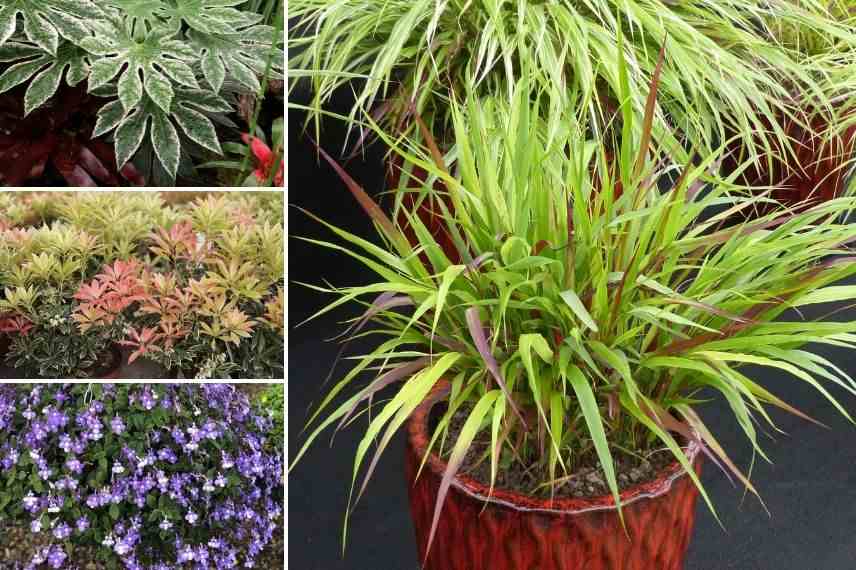
Fatsia japonica ‘Spider’s Web’, Pieris ‘Flaming Silver’ (photo Denolf), purple Streptocarpus (photo Rudy Raes), and Hakonechloa macra ‘Beni-Kaze’
In a border full of flexibility
With their languid habit, the Hakonechloas make excellent border plants. You can use them continuously to highlight a flowerbed or frame a shaded path, or plant them in repetitions or staggered arrangements, alternating with other groundcover plants like Myosotis, with their delicate blue flowering. Visually similar and boasting very decorative foliage, sometimes with a metallic silver-grey hue, Brunneras are true perennials that thicken over time. Also try the creeping Bugles, whose evergreen foliage takes on green, bronze, or variegated shades, or the Alchemillas, whose chartreuse flowers bloom from May to October depending on the variety. Aster divaricatus, such as the variety ‘Beth Chatto’, brighten the border with their star-like blooms while requiring little maintenance. Also very easy to care for, Bergenia form beautiful colonies with evergreen foliage, which often turns purple in winter, adorned with bouquets of white, pink, or red flowers starting from late winter. Other grasses can also accompany the Hakonechloa. Among them, Carex have the advantage of being mostly evergreen and offering a wide range of graphic foliage in various shades. Epimediums provide very different yet equally decorative foliage, with colours that change throughout the seasons, and adorned with delicate spring flowers.

Ajuga reptans ‘Burgundy Glow’, Hakonechloa macra, Myosotis, and Aster divaricatus ‘Beth Chatto’ (photo PBK)
- Subscribe!
- Contents
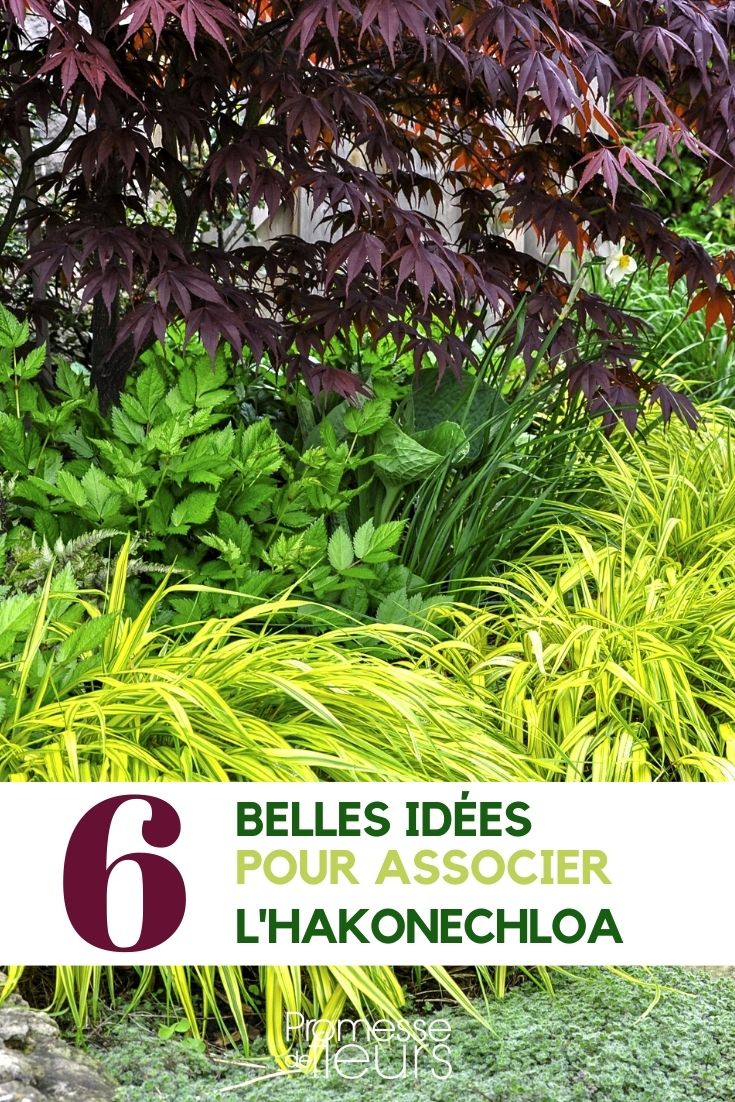
































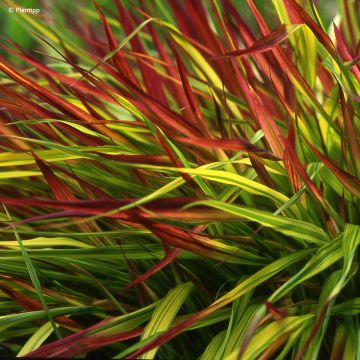
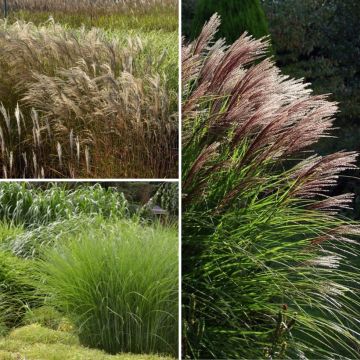
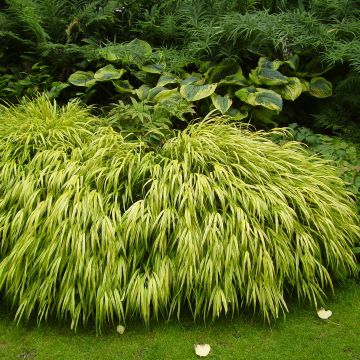

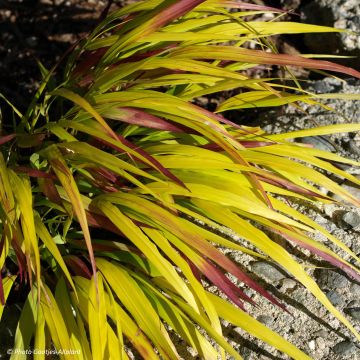
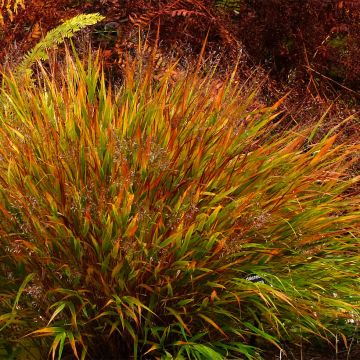
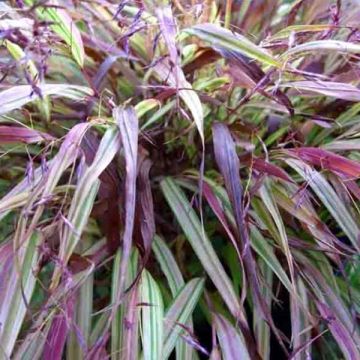

Comments